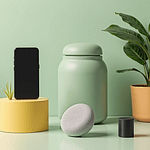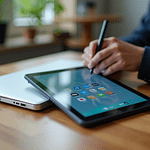In today’s world, smartphone addiction is a common challenge, with many people checking their phones every few minutes. Excessive screen time can affect mental and physical health, especially among young people. Fortunately, there are effective methods to reduce phone dependency and create healthier digital habits. This guide will explore the impacts of smartphone addiction and the best strategies to break free from it.
The Growing Problem of Smartphone Addiction
Research shows that 47% of Americans feel addicted to their phones, with the average user checking their device about 144 times per day—nearly once every 7.5 minutes during waking hours. This constant checking disrupts productivity and heightens stress. Below is a snapshot of smartphone usage trends and its impact on different age groups.
Key Statistics on Smartphone Addiction

| Statistic | Details |
|---|---|
| Average Daily Checks | 144 times per day |
| Frequency of Phone Use | Every 7.5 minutes on average |
| Percentage of People Feeling Addicted | 47% of Americans |
| Average Time Teenagers Spend on Phones | 9 hours daily |
| Percentage of Teens Feeling Anxious Without Phones | 66% |
With teens spending around nine hours a day on smartphones, this trend shows the need for actionable steps to reduce screen dependency.
The Impact of Excessive Smartphone Use on Health
Constant smartphone use can lead to mental and physical health problems, affecting sleep, posture, and emotional well-being.
Mental Health Consequences
- Increased Anxiety and Stress: The constant need to check notifications can create anxiety and stress, making it difficult for users to relax.
- Higher Depression Risk: Research links high smartphone use with a higher likelihood of depression and psychological distress.
- Sleep Disruption: Frequent phone use, especially at night, leads to poor sleep quality, with the blue light from screens delaying melatonin production.
Physical Health Issues
- Eye Strain: Staring at screens for extended periods can cause digital eye strain, leading to headaches and discomfort.
- Neck and Back Pain: Frequent phone checking can lead to “tech neck,” a condition where poor posture causes neck and shoulder pain.
- Blue Light Exposure: Exposure to blue light at night disrupts sleep, affecting overall health.
These issues underline the importance of reducing screen time and creating a balanced tech-life relationship.
Strategies to Reduce Smartphone Addiction
Breaking free from smartphone dependency requires a combination of setting boundaries, creating healthier habits, and using smartphone features wisely.
1. Adjust Phone Settings to Limit Usage
| Setting | Benefit |
|---|---|
| Disable Non-Essential Notifications | Reduces stress and interruptions |
| Enable Screen Time Tracking | Provides insights on usage patterns |
| Set App Time Limits | Prevents overuse of certain apps |
| Switch to Grayscale Display | Reduces screen appeal and time spent |
| Night Mode & Lower Brightness | Reduces blue light exposure |
Adjusting your phone’s settings is an effective first step toward breaking habits that lead to overuse.
2. Create Physical Boundaries
Physical distance from your phone can help reduce the temptation to check it.
- Charge Devices Outside the Bedroom: Charging your phone in another room helps prevent late-night browsing.
- Use a Traditional Alarm Clock: This reduces the urge to check notifications first thing in the morning.
- Designate Phone-Free Zones: Keep devices out of dining areas and other social spaces to focus on in-person interactions.
Creating physical boundaries encourages mindfulness and reduces the impulse to check your phone repeatedly.
3. Build Healthy Phone Habits
Building healthier phone habits helps reduce dependency over time. Here are some actionable steps:
- Establish Phone-Free Days: Dedicate one day per week to going phone-free, promoting a balanced lifestyle.
- Limit Home Screen to Essential Apps: Remove social media and entertainment apps from the home screen to make the phone more utility-focused.
- Use Productivity Apps: Apps like Forest and Space track screen time and encourage focus.
These small steps make it easier to use your phone purposefully rather than habitually.
Leveraging Digital Wellness Features
Most modern smartphones have built-in tools to help manage screen time effectively.
Digital Wellness Tools
| Feature | Description |
|---|---|
| Screen Time Tracking | Measures time spent on each app and sets limits |
| Focus/Do Not Disturb Modes | Mutes notifications during work or sleep hours |
| App Limits | Controls the amount of time allowed on specific apps |
| Digital Detox Apps | Tools to encourage tech breaks, like Freedom or Flipd |
Using these tools can make it easier to establish a balanced digital lifestyle.
Adopting a Mindful Approach to Smartphone Use
Beyond settings and features, mindfulness is essential to building a healthier relationship with technology. Here are some mindful approaches to reduce screen time effectively.
Mindfulness Practices
- Practice Digital Detoxing: Taking occasional digital breaks can reset your usage patterns and provide a fresh perspective on tech dependency.
- Set Intentional Usage Goals: Use your phone for specific tasks rather than as a default activity when bored.
- Use Deliberate Locking Mechanisms: Disabling Face ID or Touch ID can make unlocking your phone a more intentional act, helping you think twice before using it.
By combining mindfulness with practical strategies, users can gradually shift their habits toward healthier smartphone use.
Conclusion: Finding Balance in a Tech-Driven World
Smartphone addiction is a significant concern, impacting both mental and physical well-being. By making simple adjustments—such as tweaking phone settings, creating physical boundaries, adopting mindful practices, and leveraging digital wellness features—you can achieve a balanced tech-life relationship. Remember, the goal is to let technology serve you, not control you. Implementing these strategies will help you enjoy the benefits of smartphone use while reducing its downsides.
Take the first step today, and find a healthier, more intentional approach to smartphone use.








